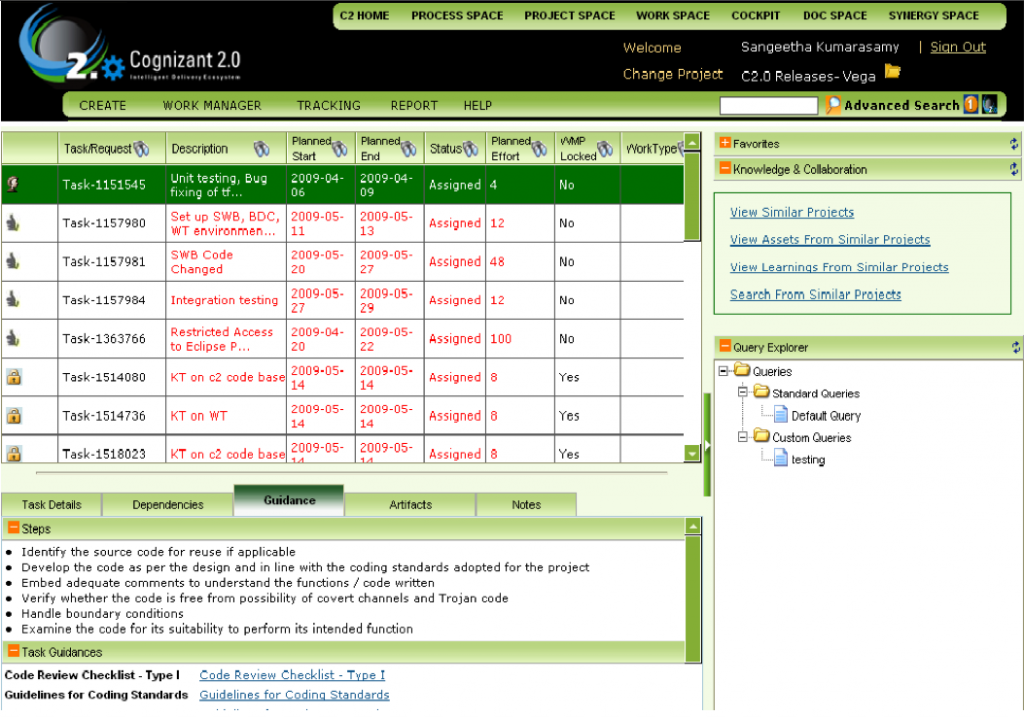 Bear with me. I only do this once a year on ITSinsider after the annual Enterprise 2.0 conference. I post a somewhat more introspective essay of sorts reflecting on what my impressions were from the conference and where I think we are as a micro-movement in the tech landscape.
Bear with me. I only do this once a year on ITSinsider after the annual Enterprise 2.0 conference. I post a somewhat more introspective essay of sorts reflecting on what my impressions were from the conference and where I think we are as a micro-movement in the tech landscape.
(If you’re really interested, you can read the first two years’ posts before reading this one: Year I and Year II.)
As I re-read Year II’s post, I realized not too much has changed from last year, and I could probably get by simply reprinting that post. But, no. There are a few things I want to address this year in greater detail.
Here we go:
 1. My Mind on my Money and my Money on my Mind
1. My Mind on my Money and my Money on my Mind
I started this post on the plane returning home from Boston (as did Oliver Marks). I snapped this photo of the guy in 27C. Blocked by his left arm is a clever little tool with which he was using to make some decisions. I overheard him telling the guy in 27B, my seat mate, that he was a manager for the terminal division for Continental. He was saying he had three projects he was evaluating, and he was trying to decide which one to do first. As I was gathering my thoughts around this year’s conference and the year ahead, I thought this little bit of eavesdropping would make for a nice intro to this blog post. The deadly little tool in Mr. 27C’s arsenal was a calculator. With a line-ruled notebook, a pen, and a calculator, he was set to make a decision that would most likely affect the work of dozens of people at Continental. And, if he did his ciphering correctly, his decision might even affect the business performance of his division at Continental Airlines. With that vignette, I’d like to suggest a lesson:
“What Enterprise 2.0 Needs to Learn from Enterprise 1.0”
Paramount on the minds of the boards of directors of the types of large firms we’re trying to move to Enterprise 2.0-style thinking and acting are items like… quarterly earnings. So, let me suggest that the currency of the Enterprise is not social connectivity, is not relationships, is not kumbaya, or even whuffie… the currency of the Enterprise is currency (and the colder and harder the better, as those clever credit financial instruments have a way of surprising you). We can debate whether ROI is a sensible metric; whether solutions are off-the-rack or tailored, whether there are enough case studies, whether we have the right brainiac analytical model, and on and on. But at the end of the day, we need to prove our business case in the Enterprise. Just like Mr. 27C, we need to run the numbers and see if our Enterprise 2.0 initiative is generating a positive business result:
- is it saving us money?
- is it making something faster?
- is it helping reduce the cost of something else?
- is it improving our customer’s loyalty and therefore repeat purchases?
- is it flattening out a supply chain and thereby reducing our costs?
- is it identifying new products or services that will throw off incremental revenue?
- is it measurably improving our performance to our primary customers?
You get the idea.
At the risk of becoming the Paul Krugman of Enterprise 2.0, I can’t emphasize this enough– quit ‘yer socializing and make some money, willya? It’s what we all need to survive. I was actually joking at the conference to my e20 friends that I’m a living example of of the hype factor in this market. I was laid off effectively six months ago, and I have not received a single (real) job offer. Therefore, my joke: “I’m too big to fail” considering (my size – that’s the funny part, and) all the good will I have amassed with my evangelism. Good will doesn’t pay the rent, my friends. I, like all my Enterprise 2.0 compadres, must find a way to make money at this or we will all be looking at working for “The Man” we are so desperate to discredit.
2. Re-thinking Diss-Organization
One of the most interesting socio-anthropological aspects of 2.0 evangelism is the dismantling (at least disrupting) of the power structures that rule large corporations. I heard it best at the conference from Marc Smith, Telligent‘s Chief Social Scientist in residence, who casually reminded us, “All social systems have power structures.” Even in the 2.0-osphere, we have a social structures. Who’s connected to whom? Who’s a social CRM rockstar? Who has more friends/followers than whom? Who gets to speak at the conference? Who gets into the best parties? Blah, blah, blah. Who are we kidding? The cruel reality is: we are social creatures driven by base human motives. Same as it ever was.
In short, it’s unlikely we will re-write the rules on social hierarchy for large organizations. What’s different, IMHO, is the role credentials and pedigree will play as we move forward in an ever-more connected world. The more we give voice to innovative ideas buried in the bowels of the organization, the more we will self-subscribe to a tacit endorsement of social darwinism. This can be liberating, yet troubling in many ways. Our peers, our management, and our reports will judge us exclusively on the merit of our contributions. Are we ready for that?
3. A word on Social Business, Social Enterprise, etc.
This last bit is a familiar refrain for these annual reflection posts. Now, with all due respect for my friends at the Dachis Group, my new writing colleague @technically_women, Jennifer Leggio who writes the Social Business blog, and the Jive marketing team (SBS), I want to raise the inconvenient issue that outside of our circle, Social Business and Social Enterprise, have a completely different meaning. Yes, we can loosely associate what we do with what “they” do, but it’s not really the same thing, is it?
“Social Businesses seek to profit from acts that generate social improvements and serve a broader human development purpose. A key attribute of social businesses is that an increase in revenue corresponds to an incremental social enhancement. The social mission will permeate the culture and structure of the organization and the dual bottom lines – social and economic will be in equal standing with the firm pursuing long term maximization of both.
Similarly, academic institutions (including this program from Harvard) have been focused on educating leaders to make a difference in the world long before we came along and decided “social business/enterprise” was a groovy fashion statement for a 2.0-transformed business.
That being said, however…
Not sure what motivated you to get into this space, but “changing the world for the better” with computer technology has always been a passion of mine. I believe it is possible to 1. make money at this and 2. use our mad skillz to right some wrongs on the planet, once we figure some things out about working socially en masse.
With that, I will return to the ITSinsider regular programming. What have you learned this year?
 Take a look at the market leaders who comprise our Council. All of the members here have been personally vetted by me. Each is engaged in some facet of Enterprise 2.0, social media, or social computing. As far as I’m aware, nothing else like this exists on the planet. We got a nice endorsement from Andy McAfee this week too.
Take a look at the market leaders who comprise our Council. All of the members here have been personally vetted by me. Each is engaged in some facet of Enterprise 2.0, social media, or social computing. As far as I’m aware, nothing else like this exists on the planet. We got a nice endorsement from Andy McAfee this week too.
 Bear with me. I only do this once a year on ITSinsider after the annual
Bear with me. I only do this once a year on ITSinsider after the annual  1.
1. 

 Well, it’s that time of year again. The
Well, it’s that time of year again. The  Here’s a tip for iStockphoto fans: CopySpace (TM). Check it out under Advanced Search. It enables you to “grid” your search by the area where you need room for copy on an image. GREAT tool for those large image slides. Not sure everyone is using iStockphoto in the enterprise, but you should definitely add this to your DIY toolkit. Some quick stats on iStockphoto include the company adds 40,000 new images and other media products a week that are vetted by 100 inspectors around the world. It has paid over $1.1M in royalties to artists, and many members of their community are making more than six figures with iStockphoto. Not really a pure enterprise product, but a great service for business folks who want to create their own visuals coupled with a strong business model that depends on community.
Here’s a tip for iStockphoto fans: CopySpace (TM). Check it out under Advanced Search. It enables you to “grid” your search by the area where you need room for copy on an image. GREAT tool for those large image slides. Not sure everyone is using iStockphoto in the enterprise, but you should definitely add this to your DIY toolkit. Some quick stats on iStockphoto include the company adds 40,000 new images and other media products a week that are vetted by 100 inspectors around the world. It has paid over $1.1M in royalties to artists, and many members of their community are making more than six figures with iStockphoto. Not really a pure enterprise product, but a great service for business folks who want to create their own visuals coupled with a strong business model that depends on community.